30 Famous Landmarks in Italy That Should be on Your List
Travel Blogger’s Favorite Landmarks in Italy!
As a land with a long, important history, a trip to Europe could not be imagined without a visit to Italy.
Ruins of the Roman Empire, Greek temples, medieval castles and impressive churches will make every history lover’s heart beat faster.
Not only does the country offer many manmade architectural masterpieces but the fascinating natural creations of mother earth itself should be on every traveler’s bucket list too.
Although I’ve been to Italy four times, I’ve only seen a tiny, tiny part of the beauty it offers. But that’s no wonder with a country of this size.
If you’re coming to Italy for the first time, planning what to see and where to go can get really overwhelming.
To help you decide, I asked more than 25 experienced travel bloggers to share their favorite landmarks in Italy + some interesting facts about Italy.
However, don’t worry if you can’t tick off each of them on your first trip. Italy is a country you’ll most likely want to visit again.
And again.
And again. 😉
(This post contains affiliate links, which means I receive a certain percentage of a sale if you purchase after clicking.)
Famous Landmarks in Rome
1. The Colosseum
Recommended by me
One of the most iconic landmarks in Italy and also one of the seven world wonders can be found in the eternal city of Rome: The Colosseum.
The ancient amphitheater was constructed between 70 and 80 AD and is the largest of its kind ever built.
It was mainly used for gladiatorial contests, theater plays, and all other different types of entertainment in the early middle age.
Until today, the remains of the massive and breathtaking structure symbolize the wealth, might, and power of Ancient Rome.
No wonder travelers from all around the world come to admire this impressive amphitheater and learn more about the history of the Roman Empire.
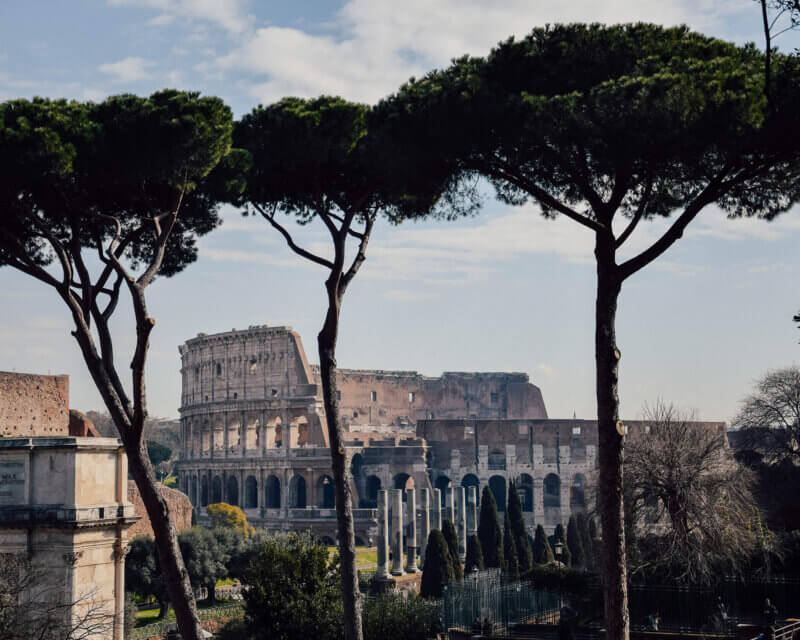
Because a visit to the Colosseum is one of the best things to do in Rome, it is usually very crowded. Make sure to get there early in the morning if you want to get the most authentic experience.
To avoid queuing, it’s recommended to buy tickets online (€21.50 for a standard entry to the Colosseum & the Roman Forum) or book exclusive tours.
Tours you might find interesting:
2. Castel Sant’Angelo
Recommended by me
On the right side of the Tiber River and just a short distance from the Vatican you can find Castel Sant’Angelo – also called The Mausoleum of Hadrian or Hadrian’s Tomb.
The castle’s initial purpose was to serve as the mausoleum of the Roman emperor Hadrian and his family. It was then later used as a fortress with prison and is now a museum.
Apparently, the urns containing the ashes were placed in what is nowadays known as the Treasury Room deep inside Castel Sant’Angelo.
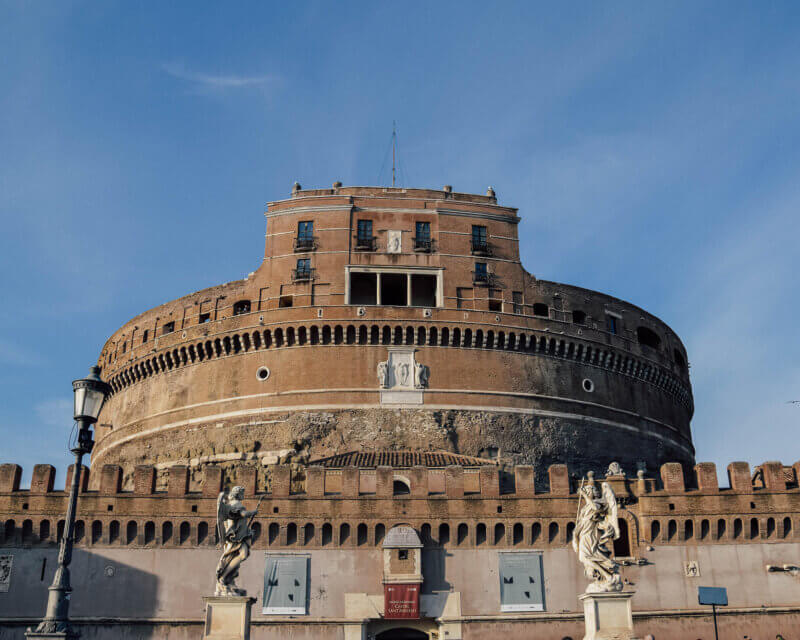
The castle can be easily reached within a 10-minute walk from Piazza Navona on the one side or the Vatican on the other side of the river.
Probably the most scenic way of approaching the castle is by crossing Ponte Sant’Angelo where you can admire marble angel statues created by the famous Italian sculptor Bernini.
The castle and the museum can be visited from Tuesday to Sunday from 9:00 am to 7:30 pm. On Friday, it’s even open until 10:00 pm.
Regular tickets cost €20.50 per person, people from 18-25 years pay €9.50 and everyone younger than that only €5.50. You can buy them online or at the cash desk.
3. The Pantheon
Recommended by Martha of May Cause Wanderlust
The Pantheon is one of those special buildings in Rome which remind you just how ancient the city is.
You can find it in a small, unassuming square, Piazza della Rotonda – like many other Roman squares, lined with cafes and bars where you can get your morning espresso, except this one has a 2,000-year-old monument in it!
It is one of the best-preserved landmarks from ancient Rome and has a classic Roman portico with Corinthian columns in front of a striking cylindrical design.
It was built around 126AD as a Roman temple and was turned into a Roman Catholic Church a few hundred years later, meaning it has been in continuous use for nearly two millennia!
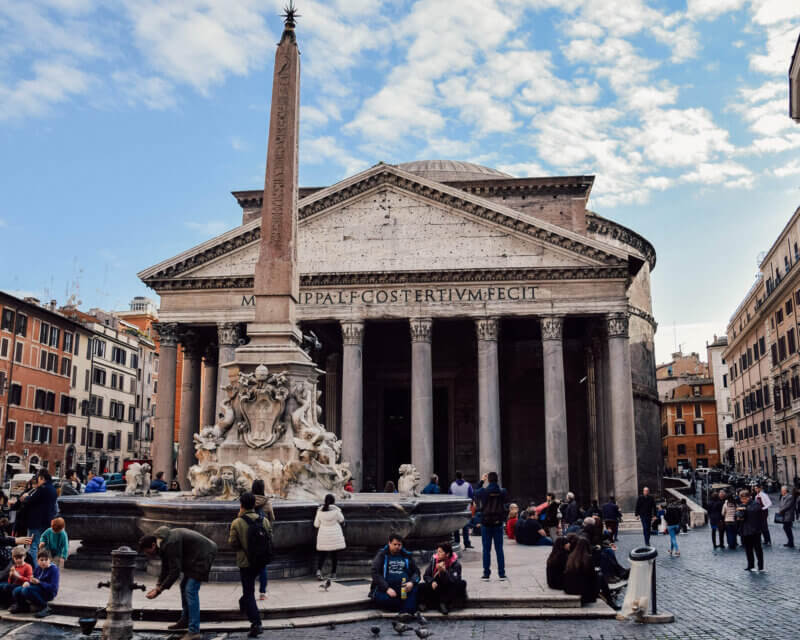
A real bonus is that the Pantheon is open to the public with no entrance fees, although if you want an audio guide or a guidebook you’ll have to pay a few euros for that.
You can visit between 9:00 am and 7:15 pm Monday-Saturday and 9:00 am and 5:45 pm on Sundays.
Tours you might find interesting:
4. Trevi Fountain
Recommended by Anda of Travel for a while
Trevi Fountain has to be the most famous fountain in Europe, one of Italy’s landmarks, and Rome’s top attractions.
The amazing Baroque fountain was created by Nicola Salvi, who was commissioned to build a dramatic fountain at the junction of three streets. Tre vie in Italian means ‘three streets’, hence the name of the fountain.
When you think about Rome, Trevi Fountain with its beautiful sculptures is one of the first images that come to mind.
The fountain was made famous by a few movies, one of them being La Dolce Vita by Fellini.
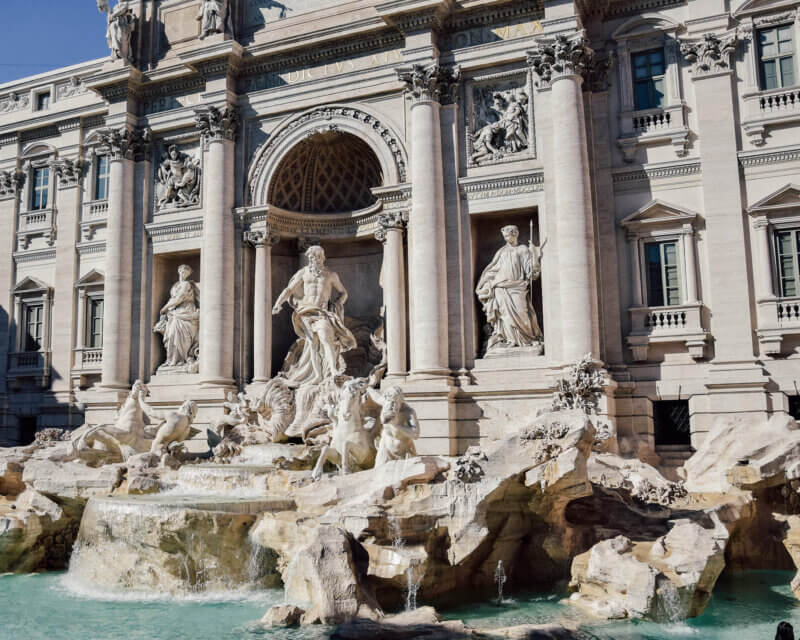
Trevi is free to visit and there’s always a good moment to pass by it and discover something new. It looks beautiful early in the morning when you’ll get the chance to be alone there, but also during the sunset.
At night it’s illuminated so you can still admire it. You will want to stay a few moments every time you pass by Trevi, on your way from or to the Pantheon, or the Spanish Steps.
Make sure to throw a coin over your left shoulder into the fountain and make a wish that is bound to come true. This is definitely one of the best things to do in Rome!
There are even more fun facts about Trevi Fountain if you’re interested to learn more about it.
5. Altar of the Fatherland
Recommended by Claudia of Strictly Rome
The Altar of the Fatherland (Altare della Patria, in Italian), is one of the most famous buildings in Rome.
Also known as Vittoriano or Monument to Vittorio Emanuele, the building dates back to 1911, and you’ll find it in Piazza Venezia, in the heart of the city.
It’s right between the historic center of Rome and Via dei Fori Imperiali, the large boulevard that goes along the forum all the way to the Colosseum.
The building was created to celebrate the first king of unified Italy – Vittorio Emanuele, in fact. It’s also where the Tomb of the Unknown Soldier is found – which explains why there is a perpetual flame outside.

The Altar of the Fatherland is a local’s favorite. This is where the yearly celebrations for the Day of the Republic, on June 2nd, officially take place.
The square in front is also a massive gathering place – it’s where locals went to celebrate the Italian victory in the World Football Championship in 2006.
Finally, although many don’t know it, it’s an incredible place to get views of the city. You can walk inside from Monday to Friday.
Access to the terrace is free unless you opt to take the elevator which costs €7.
6. Ostia Antica
Recommended by Leyla of Women on the Road
Everyone knows Pompeii, but among the hidden gems in Italy is Ostia Antica – an ideal day trip from Rome, only a few metro stops away.
Ostia Antica sits on the outskirts of Rome and was once the city’s official seaport until the Tiber silted up.
That takes away none of the site’s majesty, which will hit you in full force as you enter through the Porta Romana and take your first steps along the cobblestoned Decumano Massimo, the city’s backbone.
Visiting Ostia Antica is quite straightforward: pick up a pamphlet at the entrance and follow the map.
But what is more fun is to simply wander down the “back alleys”, away from other visitors to the less well-kept sections of the city, those parts where you might stumble upon an unrestored fresco or an abandoned statue.
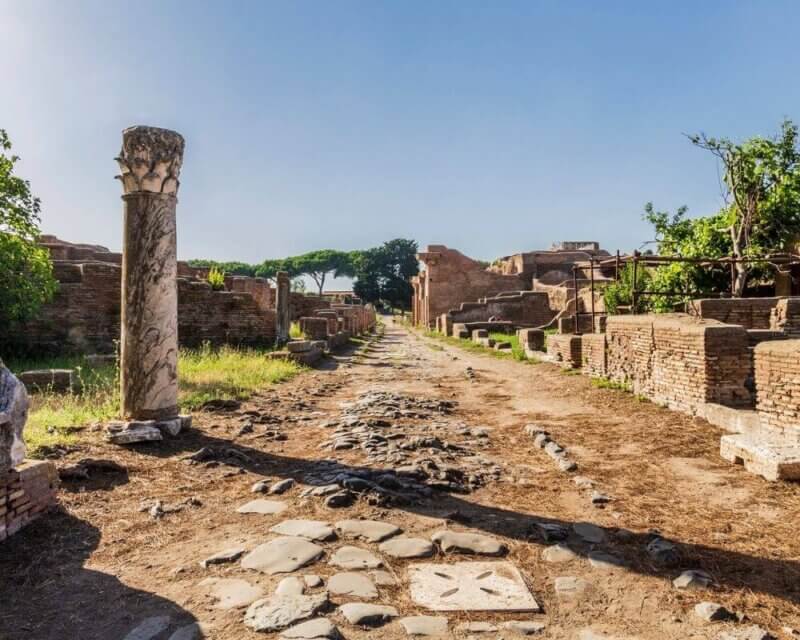
If you love Roman ruins, you’ll be well served here: a giant theater, baths and barracks, temples, and even a basilica and a synagogue.
To get to Ostia Antica, hop metro Line B to Piramide. Then switch to the Roma Lido commuter train and get off at Ostia Antica.
A short ten-minute walk will get you to the ancient Roman city, where you’ll need a good two hours to wander around, and if you’re a real ruin fanatic, three would be better.
Ostia Antica is closed on Mondays and some holidays. It has staggered closing hours but opens at 8:30 am, an ideal time to visit if the day is hot. The entry price is €12.
Tours you might find interesting:
7. Spanish Steps
Recommended by Kenny of Knycx Journeying
The Spanish Steps are one of the most visited and photographed attractions in Rome.
They were built in the years between 1723 and 1725, starting from the Trinità dei Monti at the top, to the Fountain of the Boat at the bottom.
While they are just “steps” that don’t sound like anything special, they hold a unique sentiment to the locals because they were so beautifully designed, the Spanish Steps became an inspirational location for artists, painters, and poets to find their muse.
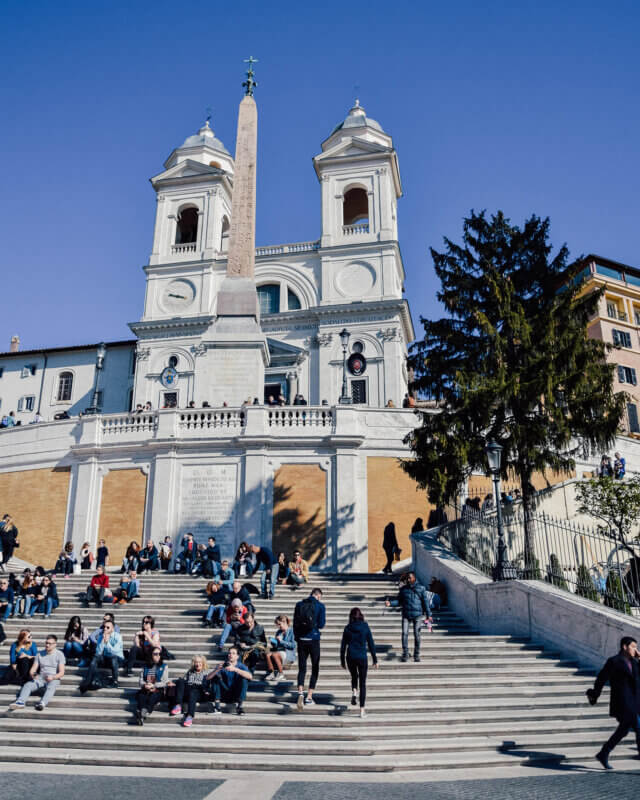
In 1986, there were protests when the first Mcdonald’s in Italy was opened near the Steps, claiming that the fast-food chain store destroyed the beauty and elegance of this attraction.
The protests led to an international Slow Food movement three years later.
Today, the steps are a perfect location where visitors can just sit on the steps, enjoy some gelato and take in the breathtaking view of Rome at the top.
The steps are open to the public and they are free, so it gets crowded in the afternoon – visit there early in the morning if you want to take pictures of the Spanish Steps with a lesser crowd.
Popular Landmarks in Venice & Milan
8. Rialto Bridge
Recommended by me
Of the countless bridges spanning the many canals in Venice, there’s one that clearly sets itself apart from all others.
The speak is of Rialto Bridge, the oldest of the four bridges connecting both sides of the Grand Canal.
Rialto Bridge was first constructed in 1173 but was rebuilt several times after and is now a major tourist attraction and one of the most famous landmarks in Italy.
Due to its popularity, it can get very crowded, making it very difficult to cross.
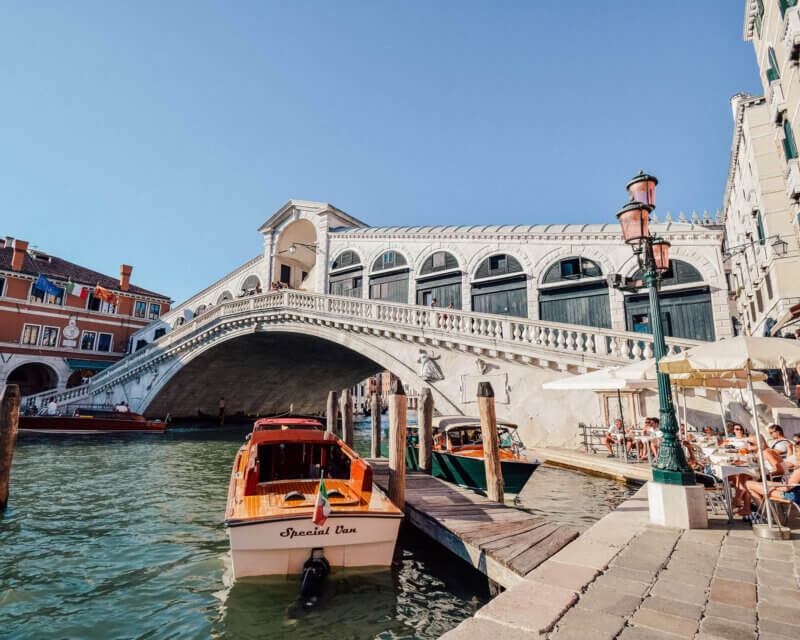
Probably the best time to go there is very early in the morning to enjoy the quiet and calm beauty of the bridge.
It’s also a beloved sunset spot because standing on top of this impressive architectural masterpiece and seeing the orange-colored reflections on the gorgeous Venetian houses is truly magical and one of the best things to do in Venice.
At both ends of the bridge, you’ll find lovely cafés and restaurants serving typical Italian cuisine. Plan enough time to sit down, relax and enjoy a real Italian espresso or a big bowl of spaghetti.
9. St. Mark’s Basilica
Recommended by Haley of Haley Blackall Travel
Venice is chock full of famous landmarks, but one of the most notable is Saint Mark’s Basilica.
Standing in prominence as a show of Venice’s power and wealth in the 11th century, the Byzantine-style cathedral is the highlight of the picturesque San Marco Square.
The church itself was built to honor St. Mark the evangelist. Over a century’s worth of history is kept in the basilica including treasures from the Crusades and Constantinople.
The four bronze horses are reason enough to visit this famous Italian landmark but add the icon of the Madonna Nicopeia, the Pala d’Oro, and many relics, crosses, and chalices, and the cathedral will be sure not to disappoint.
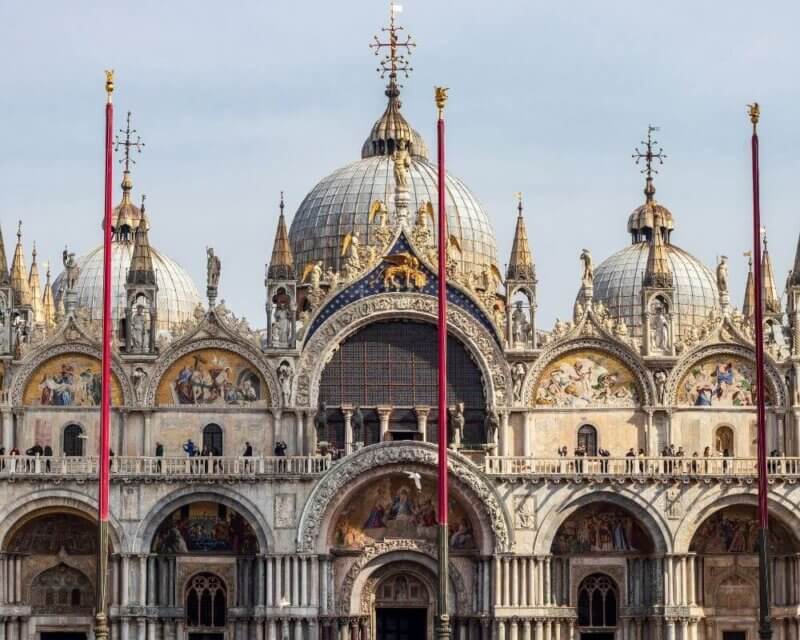
Make sure to take time to enjoy the top-level balcony for a bird’s eye view of San Marco Square, and peruse the grand interior architecture to your heart’s content.
Spend two hours here to properly immerse yourself in history.
Opening hours for the Saint Mark’s Basilica are Mondays through Saturdays 9:30 am until 5:00 pm and Sundays from 2:30 to 4:30 pm. The entrance to the basilica is free, but to enjoy the museum, tickets are €5.
Relevant tours you may find interesting:
10. Duomo di Milano
Recommended by Melissa of Parenthood and Passports
The Duomo di Milano is not only one of the most spectacular examples of Gothic architecture in the world but also one of the most famous landmarks in Italy.
The stunning cathedral in Milan’s city center took more than 600 years to construct.
With a shocking 34,000 statues on and inside the church, 55 intricate stained glass windows, and 135 spires adorning the exterior, the cathedral is considered a masterpiece of religious architecture.
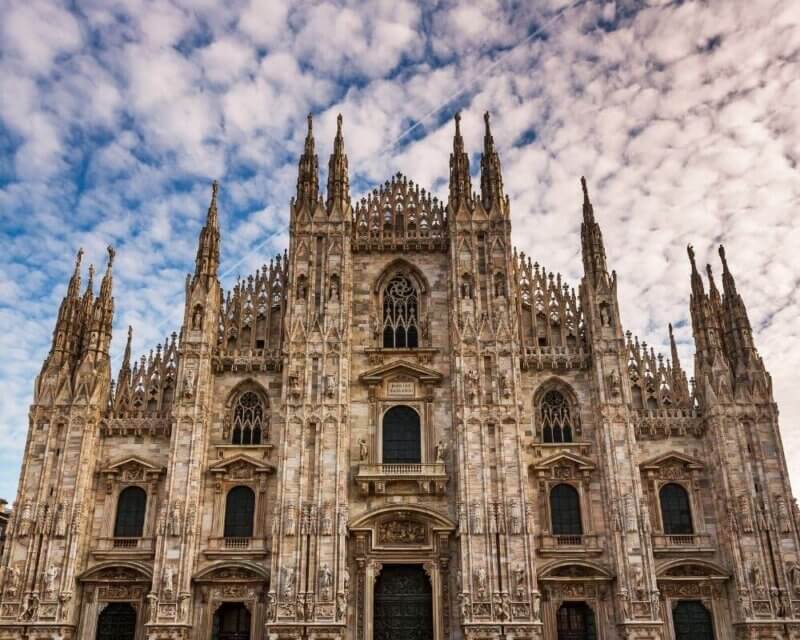
To tour the inside of the Duomo, the connected museum, the archeological area, and the beautiful terraces overlooking the Duomo plaza, admission is €15.
From the 26,250 square foot terrace, you can not only see the detailed exterior pinnacles and spires up close but on a clear day, you can even see as far as the Italian Alps!
Tours you might find interesting:
The Milan Duomo is the largest cathedral in Italy and the second-largest Catholic cathedral in the world, behind the Seville Cathedral in Spain.
If planning a multi-city trip across Italy, it is worth spending at least one day in Milan just to see this notable church.
11. Galleria Vittorio Emanuele
Recommended by Roxanne from Faraway Worlds
The Galleria Vittorio Emanuele II is a beautifully designed shopping arcade built in Milan in the 19th Century and is a must to visit on any northern Italy itinerary.
The Galleria consists of two glass-vaulted arcades which form a Latin cross and is situated between the Duomo and La Scala theater.
There’s also a mosaic on the central dome which depicts the known continents at the time – Africa, Asia, Europe, and America.
The interior is mesmerizing, with gently filtered light and a range of high-end boutiques. It’s like walking through a cathedral devoted to shopping.
There are also a number of excellent cafes and restaurants in the arcade, so be sure to visit around lunchtime.
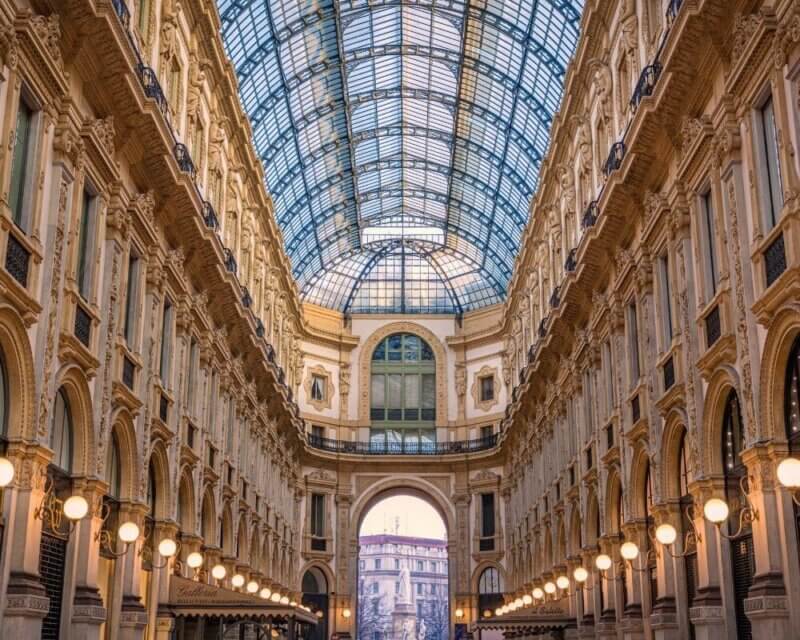
Under the central dome, you’ll find a mosaic that includes the Savoy coat of arms and a number of animals representing Italian cities. The bull on the mosaic is of special significance.
On New Year’s Eve, people step on the testicles of the bull with their right foot and turn around with their eyes closed. Doing this is said to bring good luck for the year ahead.
It’s a tradition that’s popular with both locals and visitors alike.
Famous Landmarks in Florence
12. Duomo Cathedral
Recommended by Soumya of Stories by Soumya
Florence’s Duomo Cathedral topped by a splendid Renaissance dome designed by Filippo Brunelleschi is one of Italy’s unmissable landmarks.
Also known as Basilica di Santa Maria del Fiore, the Duomo Cathedral is one of the most visited attractions in Florence and a true architectural masterpiece.
The huge Gothic structure, which took almost 140 years to be completed, features some of the most exotic frescoes in Europe.
However, what makes the cathedral truly unique is the massive Brunelleschi dome that can be spotted from anywhere in Florence.
Fascinating mosaics adorn the interior of the dome with Giorgio Vasari’s Last Judgement being the most impressive.
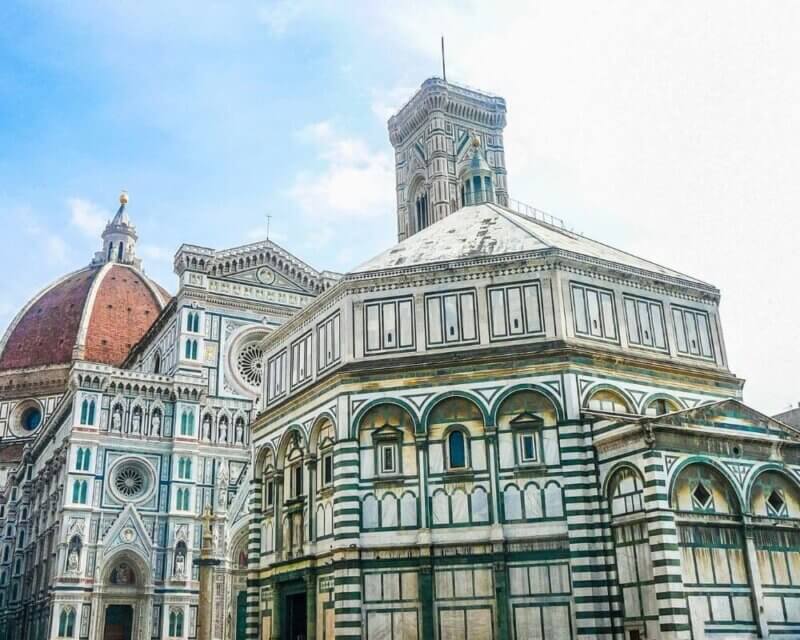
The Duomo Cathedral is located at Piazza del Duomo and is free to enter. But you will need a ticket to climb the dome and to access other monuments in the complex such as the Baptistry, the Museum, and the Bell Tower.
Check for admission prices and hours on the official website of the cathedral.
Apart from seeing the dome from inside and climbing up to get some amazing views of the city, be sure to head to Piazzale Michaelangelo for a view of the Duomo against the colors of sunset.
You will be rewarded with the most mesmerizing sight of your life.
The area around the Duomo Cathedral is also a good place to go if you don’t know where to eat in Florence as there are many great restaurants. Plus there are a lot of activities to do in Florence with kids!
Tours you might find interesting:
13. Ponte Vecchio
Recommended by Linn of Brainy Backpackers
Ponte Vecchio dates back to 1345 and is now one of the most prominent landmarks in Italy.
The medieval stone bridge was the only bridge in Florence that survived the Second World War bombings. It started out serving as a defense bridge and was the first one of its kind to cross the Arno River.
Today, it is visited by millions of tourists for its unique design looking like little pastel dollhouses with windows plastered to the bridge walls.
Ponte Vecchio is buzzing with jewelry shops and antique boutiques and is the gateway to the old town, so a true must-add to your Florence itinerary.
Combine a stroll across the river with eating mouth-watering gelato from any of the nearby gelato bars.
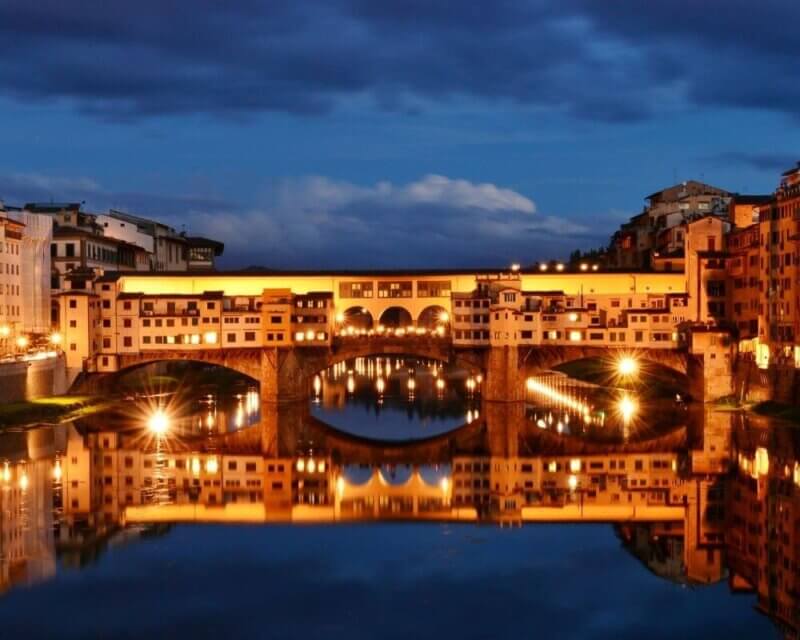
For a panoramic view of Ponte Vecchio, head to the Piazzale Michelangelo viewpoint where you see the whole city.
You get a good view of Ponte Vecchio, which might just be one of Italy’s most photographed bridges.
14. Uffizi Gallery
Recommended by Sophie of Just Heading Out
Palazzo degli Uffizzi, also known as the Uffizzi Gallery, is one of the most famous museums in the world. It lies in a beautiful Renaissance building in the center of Florence.
The Uffizzi was initially built as offices for the local government, this is where the museum gets its name (Uffizzi is Italian for offices).
It was owned by the influential Medici family, who were known as patrons of the arts, and has been open to visitors since the 16th century.
Inside the museum, you can admire a wealth of paintings by world-famous painters, such as Leonardo da Vinci, Giotto, and Raphael.
The crowning glory of the collection is Sandro Botticelli’s Birth of Venus. The architecture and decoration of the museum itself are also stunning.
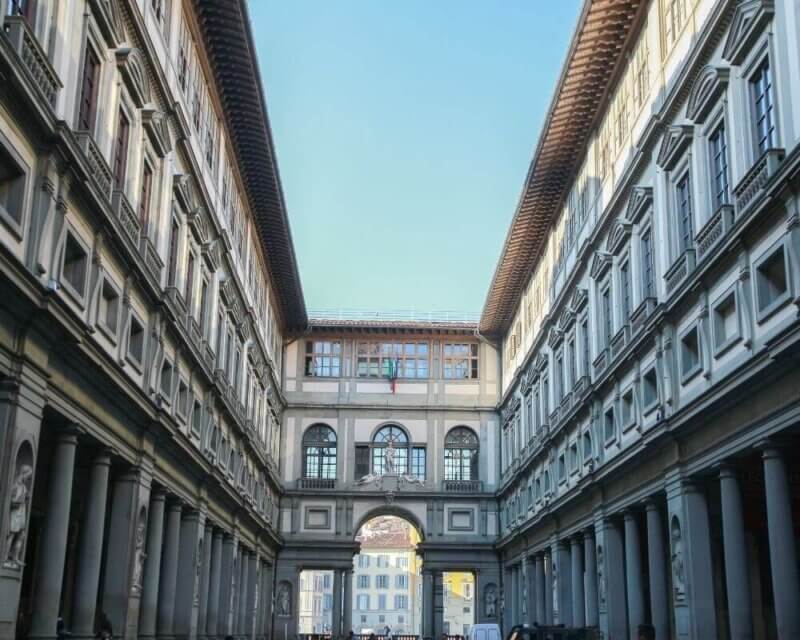
A regular ticket costs €20, €2 for EU citizens between 18 and 26 y.o., and free for children. The museum is open from Tuesday to Sunday, 8:15 am to 6:50 pm.
It is recommended to make a reservation in advance to avoid waiting in line, especially in summer and on weekends.
You can see the highlights of the Uffizzi in one afternoon, but if you love Italian Renaissance art, you could probably spend days here.
Natural Landmarks in Italy
15. Saturnia Hot Springs
Recommended by Martina and Jürgen of PlacesofJuma
Saturnia in Tuscany is definitely one of the most worth-seeing landmarks in Italy!
These breathtakingly beautiful hot springs are located in the picturesque Maremma, in the province of Grosseto, and are certainly the most famous natural attractions of this region.
Although Tuscany has more hot springs to offer, for example, the Bagni San Filippo Hot Springs, Saturnia Hot Springs are the most popular ones.
When you visit this natural jewel, you can expect a backdrop straight out of a travel magazine: turquoise blue pools, steaming white sinter baths, and unspoiled nature with the hot river guarantee some fabulous photo opportunities and delight visitors from all over the world.
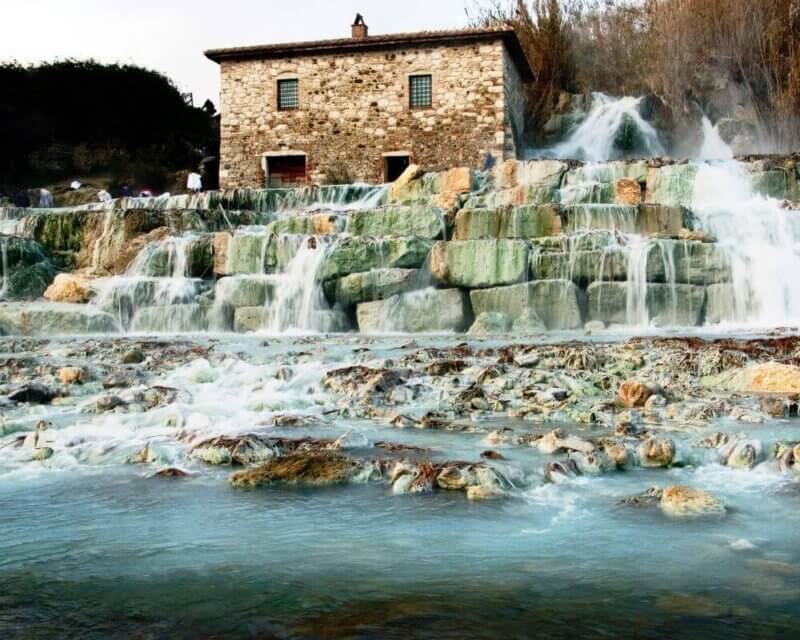
These natural springs are even accessible free of charge and can be visited all around the clock. However, they are most beautiful at sunrise, when the pools glow blue and the water steams picturesquely.
But not only the scenery of Saturnia is ingenious, but also the healing effect is unique. The water has a very high sulfur content and is therefore effective against inflammatory diseases such as rheumatism and arthritis.
On top of that, the thermal springs are said to have a rejuvenating effect.
16. Mount Etna
Recommended by Annabel of Smudged Postcard
Italy is a land of great natural wonders and one of its most famous can be found on the island of Sicily – Mount Etna.
This active volcano – which frequently puts on an impressive display – can be found on the northeastern side of the island just inland from the city of Catania.
Mount Etna is over 3,000 meters high. You can ski down the mountain – which makes it one of the best places to visit in Italy in winter – but the main draw is its volcanic nature.
Although there’s a cable car taking visitors near the summit, it’s worth taking a guided tour of Mount Etna to gain a full understanding of this “Mother of Sicily” as the volcano is sometimes known.
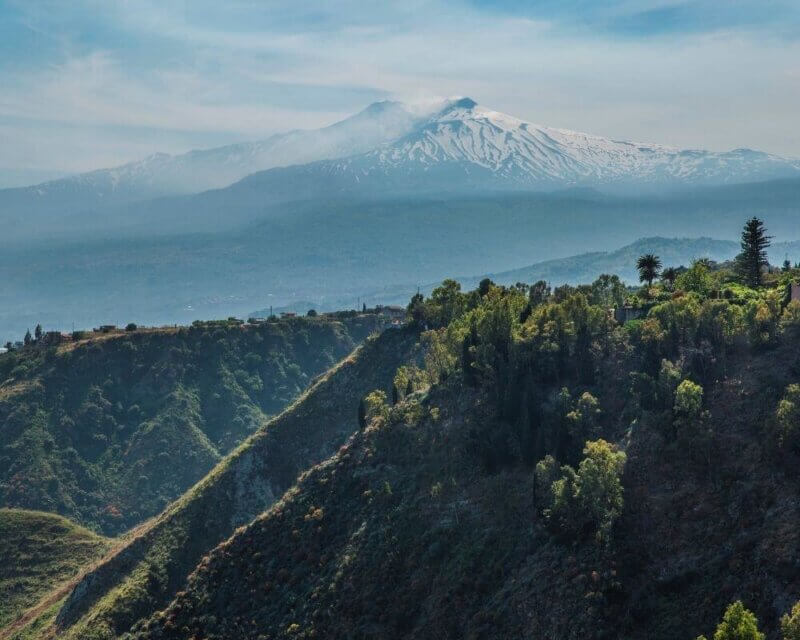
Getting off the beaten track on Mount Etna, visitors can explore ice caves and discover lava bombs as well as see incredible views of old lava flows.
Mount Etna can easily be visited on a day trip from the popular seaside town of Taormina.
Tours you might find interesting:
17. Lake Como
Recommended by Paula of Paula Pins the Planet
One of the most beautiful natural landmarks in Italy and one of the most scenic destinations is Lake Como.
Just a short trip by train from Milan, Lake Como draws travelers from all over the world to enjoy the stunning lakeside villas with their colorful houses surrounded by mountains.
The diverse landscape gives ample choices to explore this stunning Italian area. Lake Como is located in Northern Italy and is the third-largest lake in the country.
It’s also not far from the Swiss border and very close to Milan and Lugano.
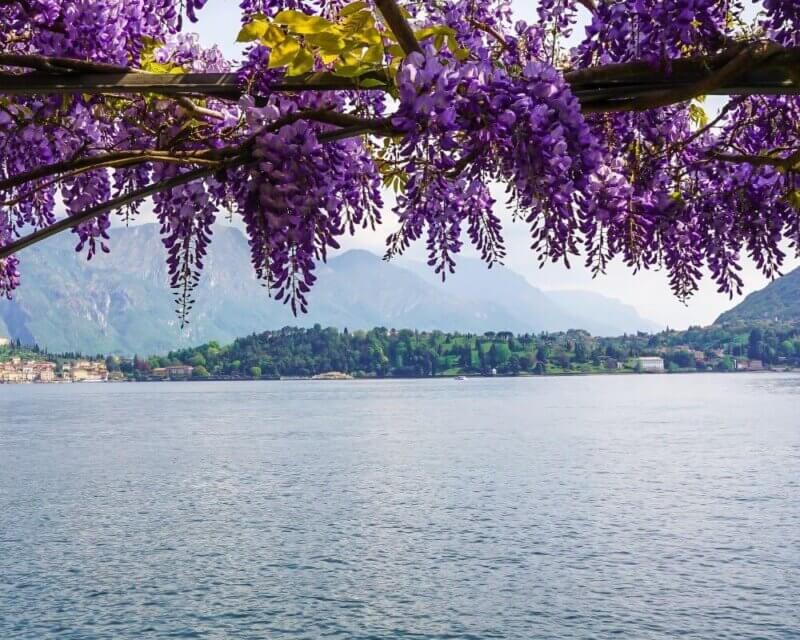
It is a great destination all year round, but in summer you can expect larger crowds and busy restaurants and hotels.
It is possible to visit Lake Como on a day trip, but if you want to travel around Lake Como and explore the villas of Bellagio, Menaggio and Varenna, make sure you reserve at least three days in your itinerary.
18. Grotte di Castellana
Recommended by Maria & Katerina of It’s All Trip To Me
One of the many regions of Italy, Puglia in Southern Italy, is abundant in natural wonders.
Among the best places to visit near Bari, Puglia’s vibrant capital, is the impressive Grotte di Castellana or Castellana Caves complex.
First explored in 1938, the caves are in fact more than 90 million years old. The Grotte di Castellana features many chambers of unique geological significance and utter beauty.
The most impressive among them is the White Cave, a glistening chamber decorated with countless white stalagmites and columns.

A visit to Castellana Caves is possible by guided tour only.
There are two itineraries available: the complete itinerary lasts for about two hours and costs €18, while the partial itinerary lasts for about 50 minutes and costs €15 per person.
Keep in mind that only the complete itinerary reaches as far as the White Cave. Be aware that the temperature inside the caves remains the same throughout the year at about 14°C to 18°C and that the floor is rather slippery.
Grotte di Castellana is an adventurous place to explore and a must-stop if you plan a Puglia road trip!
Other Famous Landmarks in Italy
19. Leaning Tower of Pisa
Recommended by Debbie of WorldAdventurists
One of Italy’s most iconic sights, the Leaning Tower of Pisa, impresses with both, its appearance and history.
The tower leans from being built on a surface of clay, fine sand, and shells that could not hold the weight of the structure.
It took 199 years to reach completion, mainly because construction needed to be stopped during conflicts.
In 1990 the tower was closed to correct the lean. The land was siphoned out from below the surface of the tower, decreasing the lean to 13.1 feet, and it took until May of 2001 to re-open to visitors.
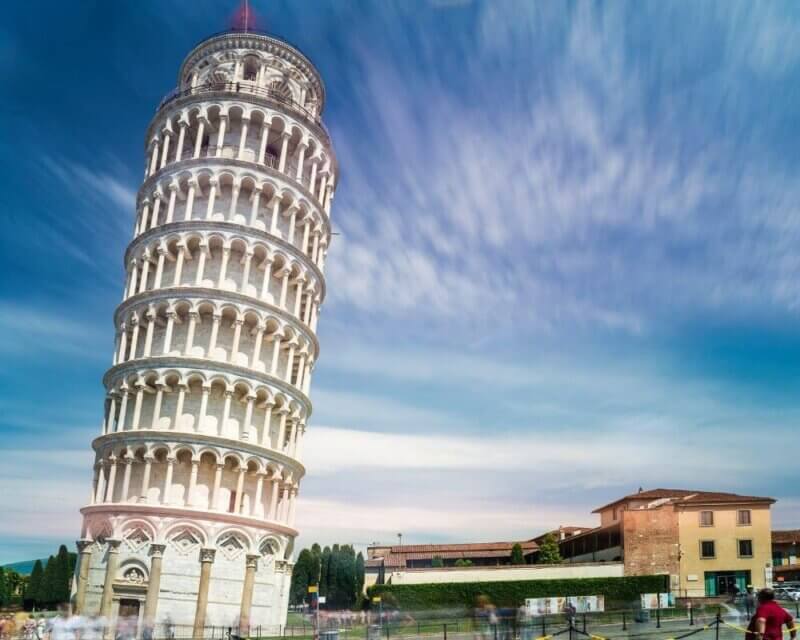
Visitors love to take a photo where it looks like they are holding up the tower. You can also climb the twin spiral staircase in the tower for a great view over Pisa. #If you want to climb the tower, it is a good idea to pre-book tickets as there is only a limited amount available each day.
When you pre-book online, tickets are € 26.50 each, with the first timed tickets starting at 9:00 am. Alternatively, you can book one of the following guided tours to get the ultimate experience:
It is possible to stop in Pisa to view the leaning tower and then move on to your next destination. However, taking a day to explore more of Pisa would give a better feel for the city.
20. Castel San Pietro, Verona
Recommended by Dhara of It’s Not About the Miles
Castel San Pietro is a must-visit in the romantic Italian city of Verona: taking photos of the city from the Castle piazza is one of the top things to do in Verona!
Located high on a hill by the Adige River, the castle is accessed via the pretty Ponte Pietra if you are walking from the main historic center.
Once you cross the bridge, you can either walk up to the castle or take the funicular one or both ways. From the funicular, you get awesome views of the city rooftops!
Castel San Pietro is a historic castle, having been built all the way back in 1398. Sadly, it was blown up in 1801 by the French army, and in 1840, the Austrians demolished what was left of the castle and the church.
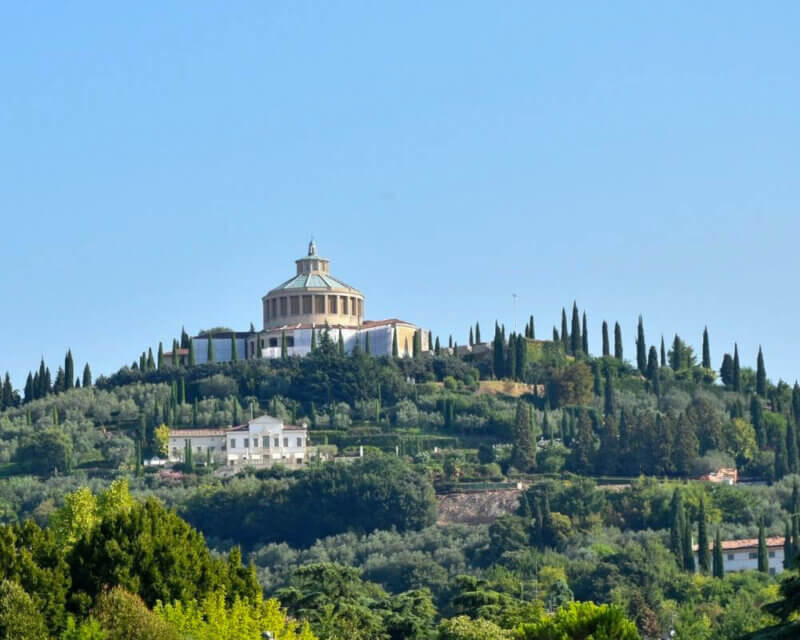
The current structure was designed by an Austrian engineer and is a military building built in the Romanesque Revival style.
You can’t go inside the structure, but the main reason you go up to Castel San Pietro is to walk the pathway just outside, for jaw-dropping panoramas of the city of Verona, laid out on both sides of the Adige River.
It is free to visit Piazzale Castel San Pietro, although there is a €2 charge for the funicular.
21. Cinque Terre
Recommended by Nadine of Le Long Weekend
The Cinque Terre is an exceptionally beautiful area of the Italian Riviera and truly one of the most iconic landmarks in Italy.
The five seaside villages are surrounded by hillside vineyards and olive groves, in a dramatic setting where the land meets the sea.
It’s exactly this unique setting plus much more why each of them deserves to be among the best Italian beach towns!
You can choose to stay within the Cinque Terre, or in a nearby town to explore the area.
La Spezia makes a good base as there is a direct train line that goes into the Cinque Terre at regular intervals during the day.
You can also get a ferry boat, or hike between some of the villages (the hiking path isn’t always open though, and it’s tough going in the hotter months!).
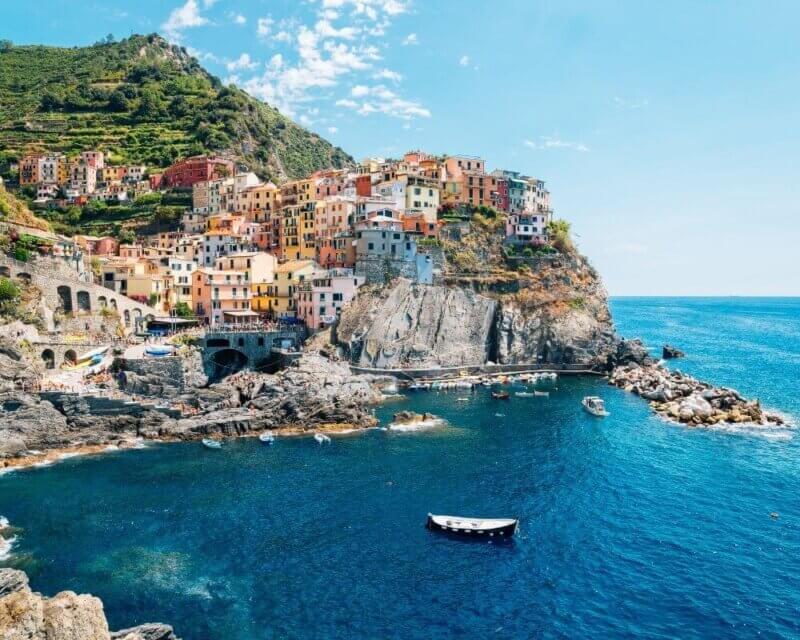
Spend at least a day, preferably two, discovering the beauty of the villages, hiking the coastal trail, swimming at the Cinque Terre beaches, and watching the sunset at Manarola or on the rocks at Riomaggiore.
You’ll be blown away by the beauty and quintessentially Italian seaside experience!
Entrance is free into the Cinque Terre National Park, but it’s recommended to buy a Cinque Terre card before your visit which gains you unlimited access to the trains that transport you between villages, and the hiking trails.
Cards start at €16/day for the combined pass.
22. Basilica of Saint Francis of Assisi
Recommended by Tom of Travel Past 50
There are actually two Basilicas of Saint Francis in Assisi, an upper and a lower church.
Both churches were started at the same time, immediately after the canonization of Francis only two years after his death in 1226.
The nave of the upper basilica is lined with scenes from the life of Francis which were, until recently, attributed to Cimabue and Giotto, the two most famous and accomplished Florentine artists of the late 13th and early 14th centuries.
The lower basilica was decorated over a period of hundreds of years and displays a variety of styles.
Along with the Giotto and Cimabue paintings, the Last Judgement by Cesare Sermei di Orvieto, painted 300 years later than the Giottos, is of note.
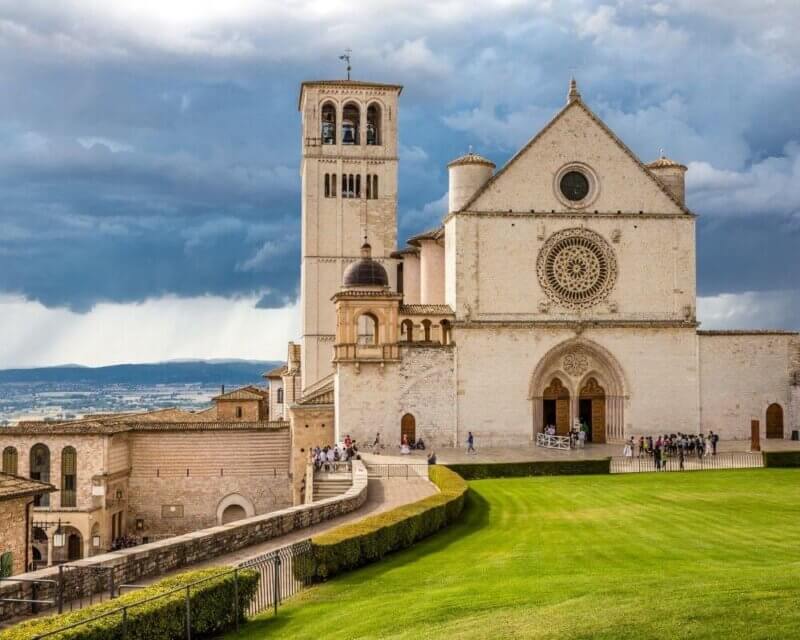
The tomb of Saint Francis itself is a simple affair in the crypt of the lower basilica.
The saint’s remains had been hidden because his original followers feared that invaders would desecrate his tomb, or that his relics would be sold all over Europe.
The Basilica is open for tourist visits from 8:30 am to 4:45 pm on weekdays and from 11:00 am to 4:30 pm on Sundays and holidays. There is no admission charge.
23. Siena Cathedral
Recommended by Agnes of The Van Escape
Siena Cathedral, also known as “Duomo di Siena,” is a medieval Roman Catholic church built between 1215 and 1263.
The Cathedral of Siena is one of the three most important churches in Tuscany. The finest Italian artists of that era completed works in the cathedral.
These artists were Nicola and Giovanni Pisano, Donatello, Pinturicchio, Lorenzo Ghiberti, and Bernini. Giovanni Pisano designed the three-axis facade.
It is a beautiful and impressive structure. The outer walls are made of white and black marble, which was transported to the construction site by the city’s citizens.
The temple floor is also made of white and black marble stripes, which makes it very special-looking. In addition, marble mosaic inlay and graffiti floors are considered the most magnificent floor ever made.
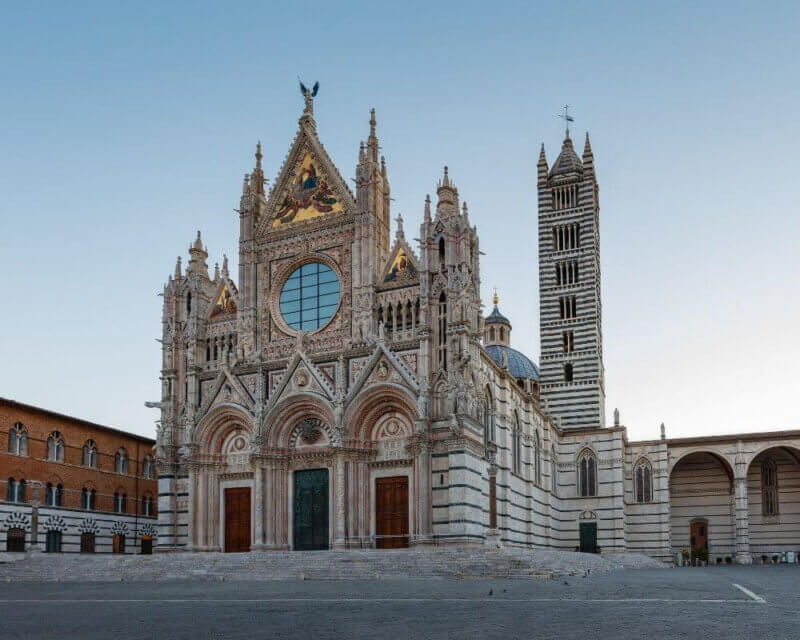
The 77-meter belfry also attracts attention. In 1339, plans began to expand the cathedral, but they did not materialize. The plague epidemic in 1348 frustrated the plan to enlarge it.
The admission fee starts from €18. It’s open every day 10:30 am – 6:00 pm / Sundays, public holidays: 1:30 pm – 5:30 pm / Eve of public holidays: 10:30 am – 6:00 pm.
It is better to buy the tickets in advance on the internet. This saves time staying in long lines.
The best idea is to buy a single ticket that also allows access to the Cathedral Roofs and all the complex museum buildings.
It is worth booking about two hours to visit the complex so you can even visit it if you have only one day in Siena.
24. Ancient Greek Theater, Sicily
Recommended by Veronika of Travel Geekery
The Ancient Greek Theater in Sicily’s Taormina belongs to prime landmarks in Italy. The well-preserved amphitheater is the second largest on the island, after a theater in Syracuse.
The structure was built in the 3rd century BC by the Greeks.
With the Roman Empire spreading through this part of the world, the theater was remodeled to match Roman needs – not just for musical and theatrical performances, but especially to host the gladiator games.
You can easily spend an hour admiring the amphitheater and, perhaps, even more, enjoying the views of the Ionian Sea below. On a clear day, you can even observe Mount Etna.
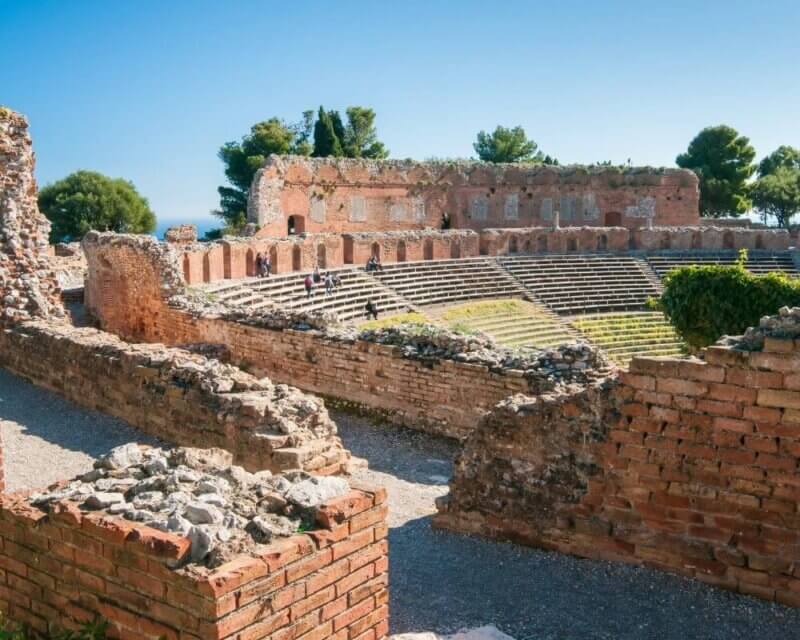
The Ancient Greek Theater is built on a hilltop, just like the whole city of Taormina.
You can find it on a street of the same name – Vía del Teatro Greco – if you turn left after Porta Messina, the main entrance to the Old Town.
The current entrance fee for adults is €10. It stays open every day from 9:00 am to 6:00 pm.
Visiting the Greek Theater is among the top things to do in Taormina. But there’s a lot more – the lovely town features a charming Old Town and a few pebble beaches.
25. Norman Palace, Sicily
Recommended by Caroline of Veggie Wayfarer
One cannot visit Palermo without learning two things: The history and the street food.
The latter is easily available on every corner of the street and at every time of day.
The former requires a little more effort, although not much because history permeates the streets of Palermo much like the smell of Arancini.
The foremost historical building to visit is the UNESCO-classified Norman Palace, dating back to the 11th century and still in use today as the seat of the Sicilian Government.
This is rather apt as the Norman Palace is the site of the very first Parliament in not just Italy, but the entire world!
The entrance to the Norman Palace can be found on Parliament Square. Make your way through the security and the gift shop before entering the oldest part of the Palace.
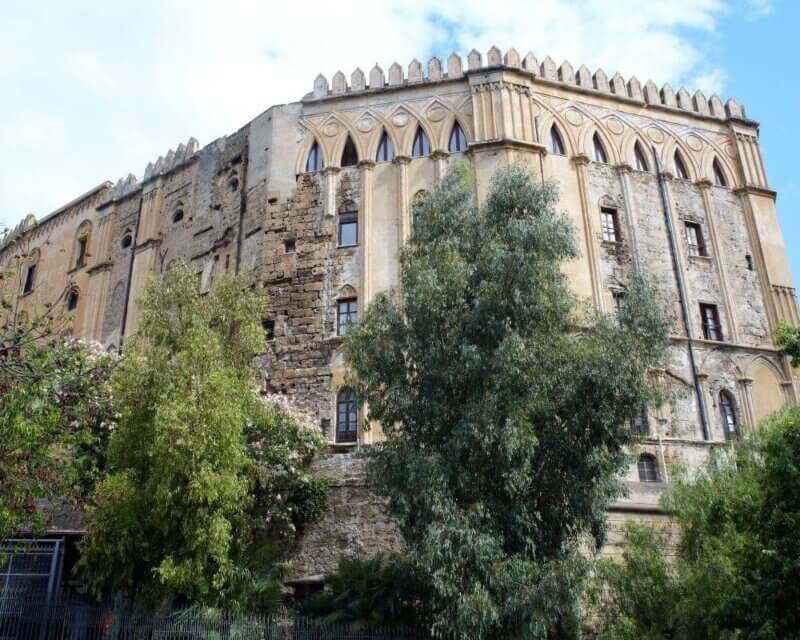
The highlight of the Palace is without a doubt the Palatine Chapel, built in the 12th century under the reign of Roger II.
It is built according to the various reigning styles at the time: Norman, Byzantium and Arabic. When walking in you will be greeted by millions of unparalleled golden mosaics depicting various biblical scenes.
After visiting the Palatine Chapel, pop in to see where the actual parliament holds its meetings (in the Hercules room) and wander through the royal apartments.
26. Trullo Buildings, Alberobello
Recommended by Jackie of Jou Jou Travels
Alberobello is a magical village in Puglia and among the most stunning landmarks in Italy. It is famous for cone-shaped homes made with dry stones known as Trullo.
It is such a unique experience to wander around this town resembling a true fairytale. In fact, it’s so special that it is one of the 55 UNESCO heritage sites in Italy for a very good reason.
You can admire the scenery surrounding you as the landscape is dotted with over one thousand Trullo homes!
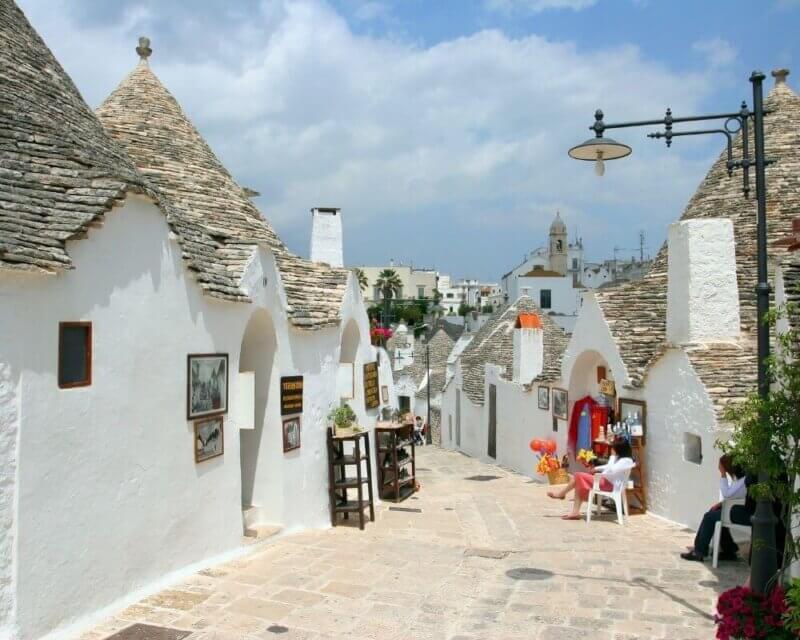
Top Tip: To see a panoramic view of them, stop by one of the many shops that show a sign saying “casolare panoramic”. With a small purchase, you can go to the top and see fantastic views.
You only need a few hours to explore the town with no necessary agenda.
You can combine the trip with other magnificent places in Puglia such as Polignano a Mare, Ostuni, and Locorotondo which will make for a nice road trip across the region.
Tours you might find interesting:
27. Due Torri, Bologna
Recommended by Chelsea of The Portable Wife
Among Bologna’s signature landmarks are the many medieval towers that rise above the city.
While over 100 towers stood during the 1300s, only about a dozen remain today. They are a reminder of the city’s wealthy past when rich families built them to defend their properties.
The Due Torri – The Tower of Asinelli and the Garisenda Tower – is the most iconic sightseeing spots in Bologna.
Located along the intersection of Via San Vitale and Strada Maggiore, the two towers are an impressive sight in the heart of the city and among the coolest landmarks in Italy.
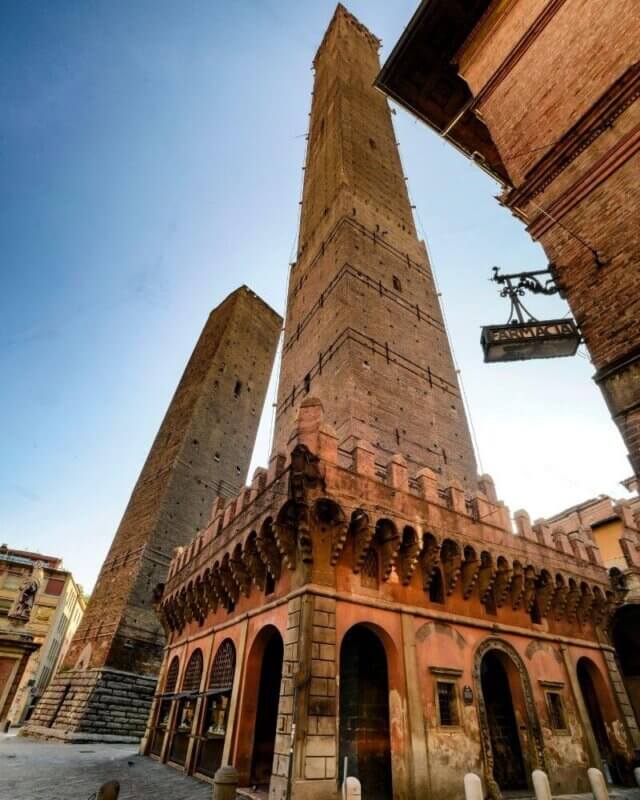
It’s also possible to climb the 97-meter Tower of Asinelli, which offers spectacular views over Bologna from the top.
Bring good shoes and prepare to be winded as the climb to the viewpoint includes 498 steps. Thankfully, there are numerous spaces to stop and rest along the journey.
Advanced booking is required to climb the tower, with time slots every fifteen minutes seven days a week. As of February 21, 2021, opening times are 10:00 am to 6:15 pm.
28. Pompeii
Recommended by Becks of It’s Just Becks
An ancient city in southern Italy, Pompeii is known worldwide as the city that fell victim to Mount Vesuvius.
In 79AD the volcano erupted, covering the area in up to six meters of ash. It wasn’t until the late 1700s that the city was rediscovered and efforts began to excavate and uncover the hidden historical site.
Over the years, Pompeii has secured a place among the best UNESCO World Heritage Sites in Europe and has become one of the most popular tourist attractions and landmarks in Italy.
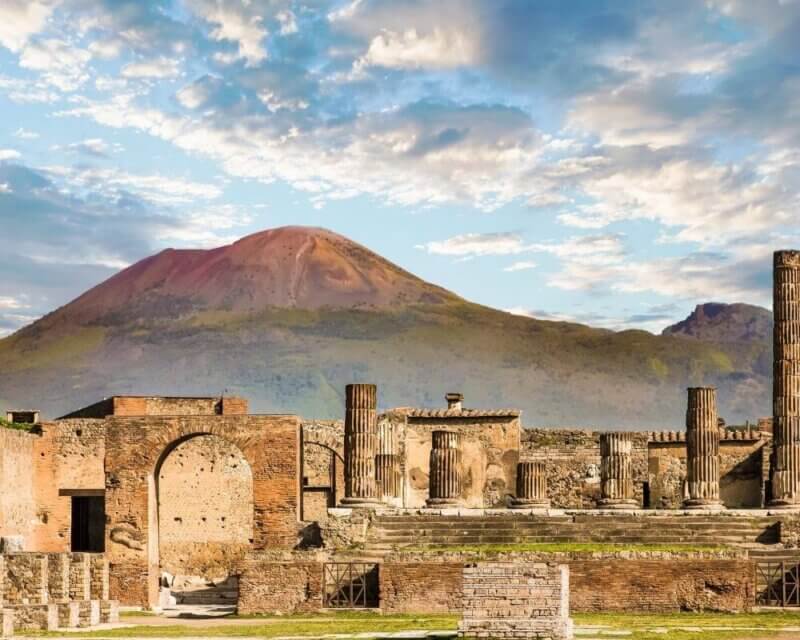
These days you can visit the site of Pompeii and wander the streets, go into many of the excavated buildings, and see what life was like when it was a thriving city.
A tour is best enjoyed with a guide, as there’s so much history and hidden details that make the whole place even more fascinating.
Tickets can be bought year-round, online, or at one of the entrances, and you’ll want to put aside at least 2-3 hours for a visit. If you want to join a tour be sure to arrive before lunchtime.
Tours you might find interesting:
29. Mole Antonelliana, Turin
Recommended by Natalie of The Best of Turin
If you look at any photo or postcard from Turin, you will see a monumental building with a huge spire taking over the city skyline.
The impressive building is called Mole Antonelliana, named after the architect Alessandro Antonelli who designed and built it from 1863 to 1889.
At that moment, Mole Antonelliana was the tallest brick building in Europe, with 167.5 meters.
The building was initially conceived to be a synagogue. However, after some issues between the architect and the Jewish community, it was bought by the Municipality of Turin.
Nowadays, it houses the Italian National Museum of Cinema and offers an incredible panoramic view from an 85 meters high terrace from where you can see Turin surrounded by the Alps.
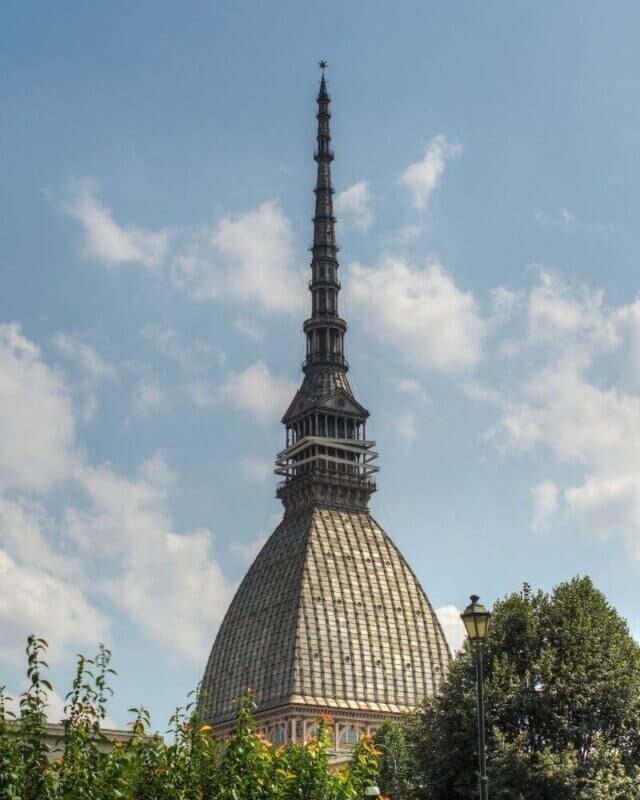
Once you are in Turin, it will be easy to find Mole Antonelliana due to its central location, close to the Royal Palace and Turin Egyptian Museum which is a few steps from Via Po.
The National Museum of Cinema and Panoramic Lift are open from Wednesday to Monday from 10:00 am to 6:00 pm.
The ticket prices are €12.50 for the Museum, €16.50 for Museum + Panoramic Lift, and €9.50 only for the Panoramic Lift.
There are discounted prices for visitors between 6 to 26 years old and children under six don’t pay.
You can purchase the tickets in advance to visit Mole Antonelliana on the National Museum of Cinema’s official website.
30. Certosa di Pavia
Recommended by Sophie of Solo Sophie
One of the most beautiful ecclesiastical buildings in Northern Italy and one of the most breathtaking landmarks in Italy is the Certosa di Pavia, a monastery in Renaissance and Gothic style that was constructed between 1396 and 1495.
The ecclesiastical building can be found around 8 km north of a city of the same name, the gorgeous university city of Pavia, and is one of the largest monasteries in the entirety of Italy.
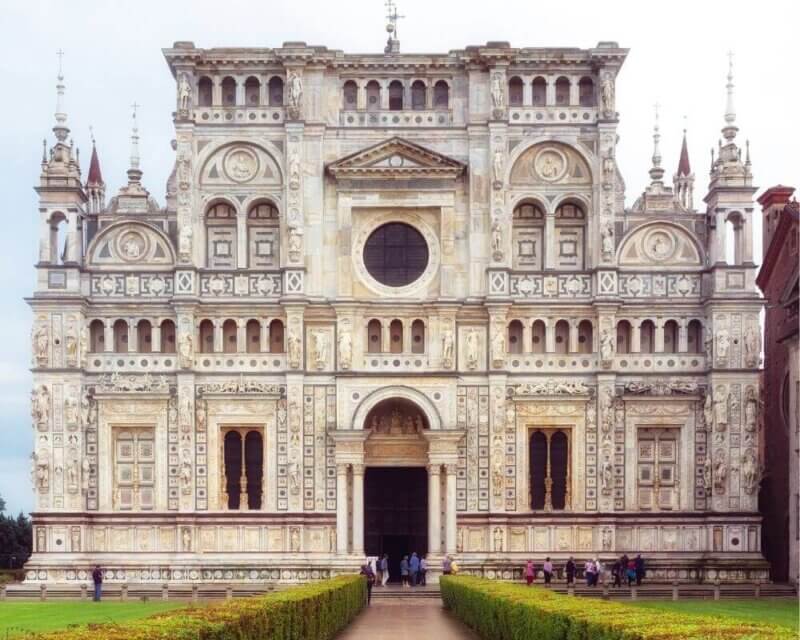
Free to visit, the monastery is open every day of the week apart from Monday. Opening times are from 9:30 to 11:30 am and 2:30 to 4:30 pm.
Throughout the day there are multiple tours (unfortunately only in Italian) that allow you access to parts of the complex that are closed to self-guided visitors.
Best seen over the course of a few hours, the easiest way to reach Certosa di Pavia is to take the train from Pavia towards Milan and get off at Certosa di Pavia.
However, be sure that the train you hop on actually stops at Certosa di Pavia as not all of them do!
Check out other famous landmarks around the world:
– 16 Most Famous Landmarks in Austria
– 22 Most Beautiful Landmarks in Germany
– 27 Famous Landmarks in California
– 27 Beautiful Landmarks in France
– 26 Most Famous Landmarks in Portugal
– 20 Beautiful Landmarks in Greece
– 16 Best Landmarks in Sweden
Like it? Pin it!
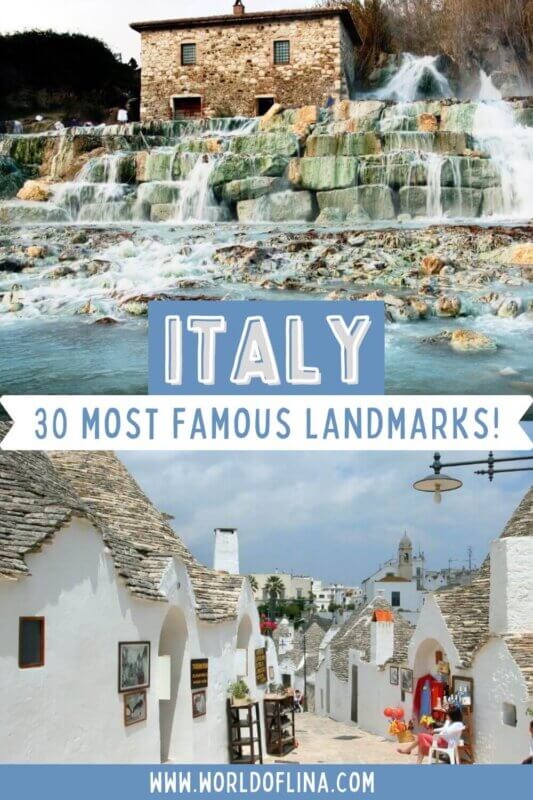
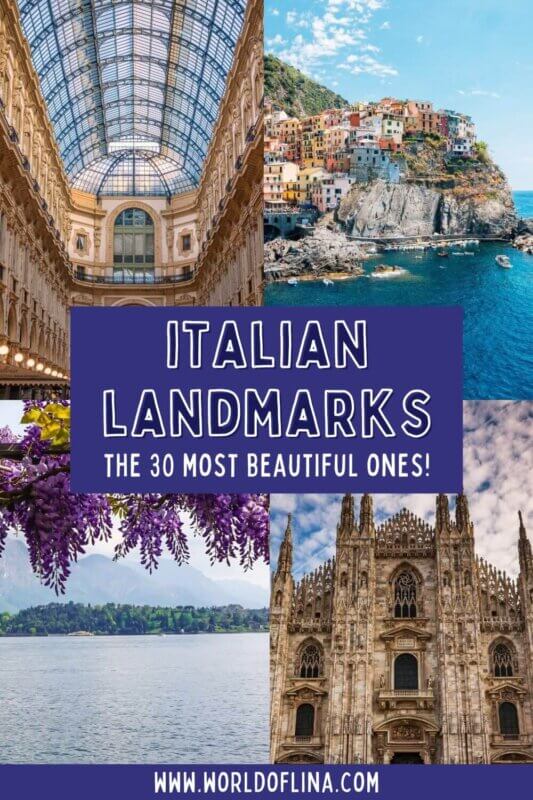
Do you want to travel like me?
Here are some of my favorite travel tips and resources:
Flights: I prefer using CheapOair or Skyscanner to book flights. The destination everywhere feature is perfect for finding some cheap deals!
Accommodation: Booking.com is my favorite site to find some great hotel deals. I do love staying at a local place as well, thus I book an Airbnb every now and then.
Travel Insurance: There are many reasons why travel insurance is important and I never travel without one. I use the simple and flexible one from SafetyWing that protects me against unforeseen events.
Tours: I love taking tours to explore destinations like a local. My favorite website to book them in advance is GetYourGuide.
Camera Gear: I use a Nikon D5300 camera with an 18-105 mm and a 10-20 mm wide-angle lens to take my photos.

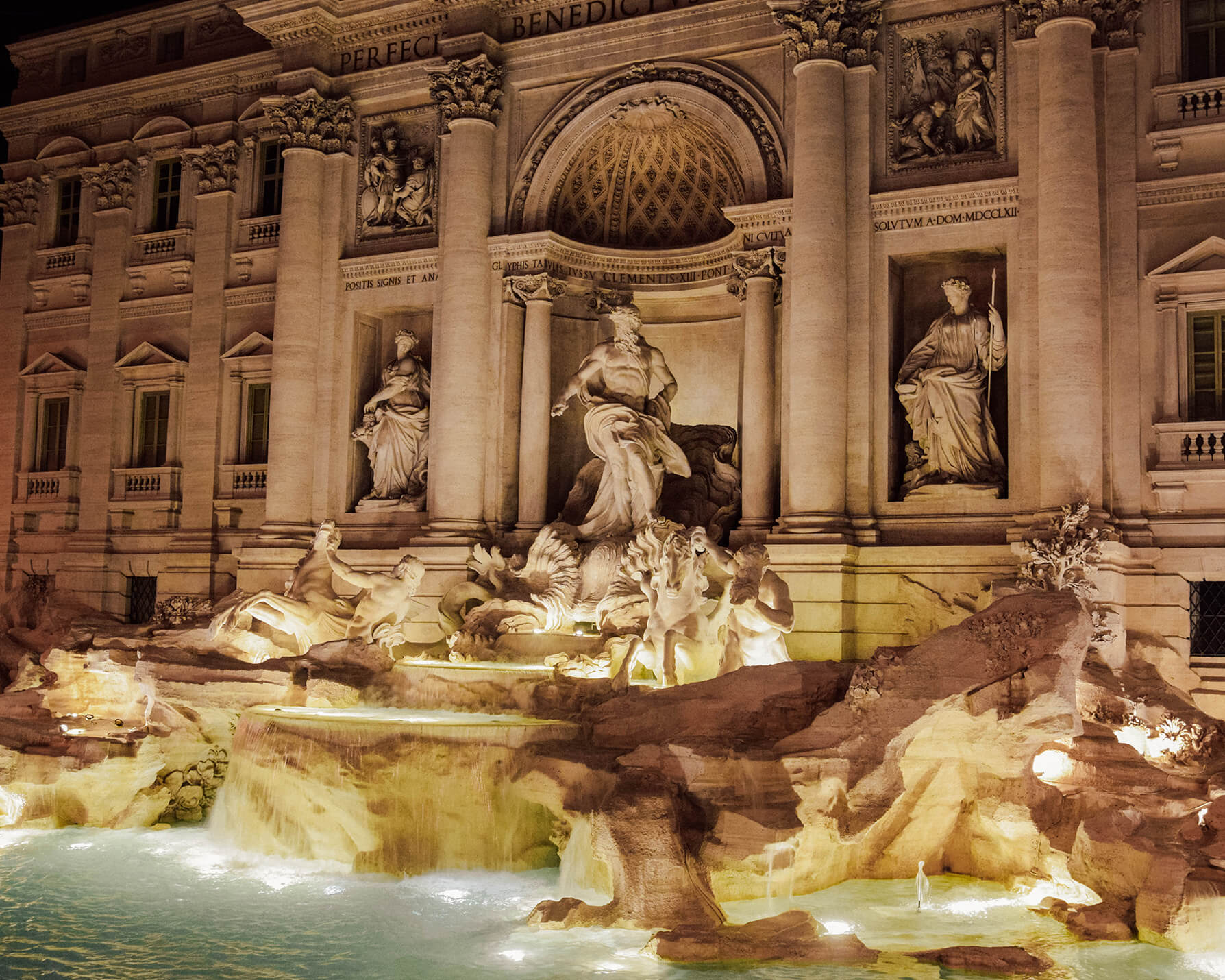


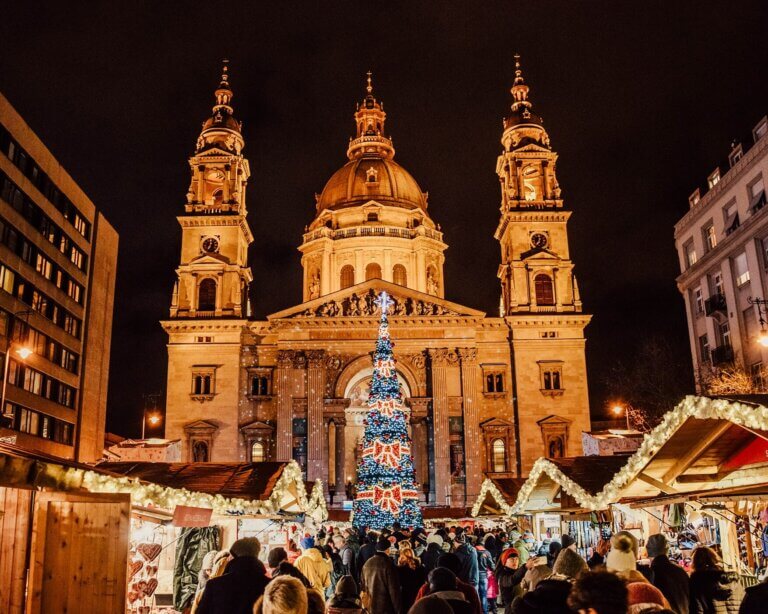


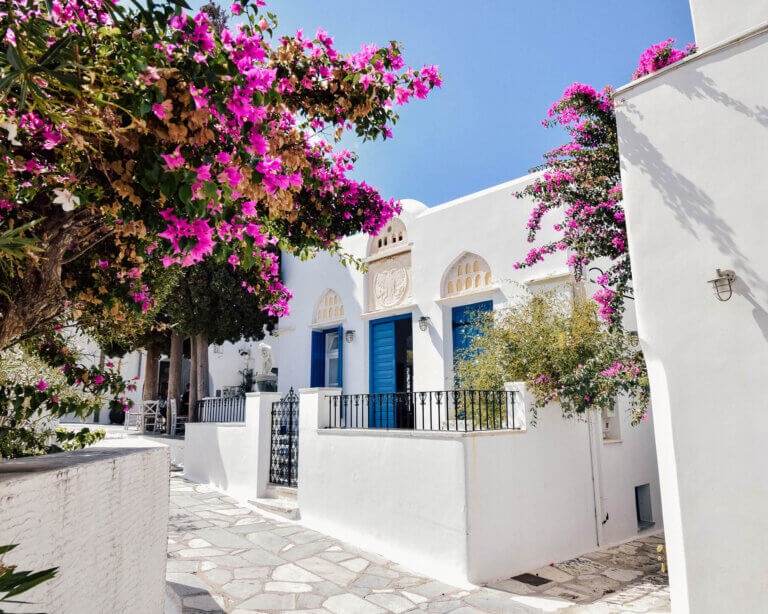
Wow, so many interesting facts! Got a great insight on the most famous landmarks in bella italia thanks to your blog post. Luckily I’ve seen a few of them already, many more to come..! Great work, keep going ??
Thanks a lot! 🙂
Also really helpful for my upcoming Rome-Trip! Will recommend this post to anyone who is planning a trip to Italy?
Oh I’m very happy to hear this, thanks so much 🙂
Wow! What a great list. I threw a coin in the Trevi Fountain and got my dream of returning – there are still plenty on your list for me to see.
Same for me! Can’t wait to get back to Rome ?
Grotte di Castellana looks amazing. I have seen similar grotte in Vietnam (near Hanoi), and loved the experience of exploring through them.
Aren’t they such fascinating places?!
This is such an extensive list you’ve put together! I haven’t been to as much of Italy as I would have liked, so most of the sites you’ve mentioned I haven’t seen in person yet. They’re all going on my list though!
Hehe there’s just so much to see!
Wow, so many good ideas! I’ve always wanted to take my mom on a trip to Italy, and this gives me so many ideas of what to see and do. Very helpful!
I hope you can go there soon 🙂
This is such a great post! I love all these sights in Rome and Venice, and I’d love to visit more of Italy, including Mt Etna. Thanks for sharing!
Thanks a lot Rachel!